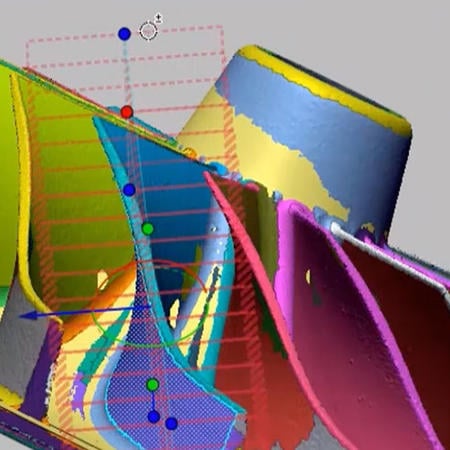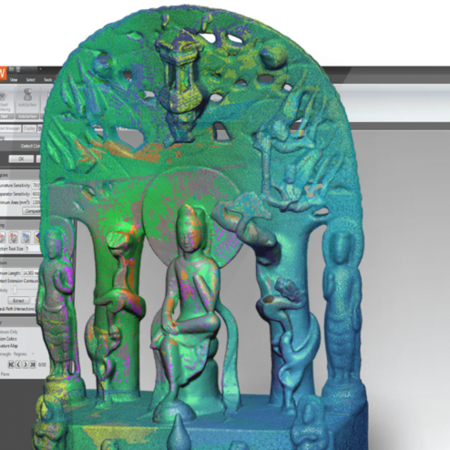3D scanning and Geomagic 3D reverse engineering software, by 3D Systems, is being used by the University of Manchester to enable the 3D modeling of both pre-historic and modern-day animals and the simulation of their gait.
Nowadays we’re all used to seeing blockbuster feature films that use computer graphics and animation technologies to portray imaginary or recreations of prehistoric animals in their ‘natural’ habitat. So on the face of it, the 3D digital modelling and animation work performed by Dr. Bill Sellers, program director in zoology at the University of Manchester in the UK, is not particularly exceptional. But it is. It’s much too realistic for an animation feature film. And that’s according to some of the best-known names in the world of animation movies.
But Dr. Sellers isn’t in the movie business. His mission is to uncover and to understand human and animal evolution: how we got to where we are today, physiologically, and the differences that have evolved between pre-historic animals and modern-day animals, including humans, over millions of years.
To help him in this mission, Dr. Sellers spends much of his time in the Animal Simulation Laboratory at the University of Manchester using the data from 3D scans of the skeletons of both pre-historic and modern-day animals to create accurate 3D digital models of those animals’ skeletons. He then uses the 3D models in the simulation of their gait using a specialized software program developed in house at Manchester University called GaitSym.
A crucial element in the overall workflow from 3D scan to final computer simulation is Dr. Sellers’ use of Geomagic 3D scanning software. This software is 3D imaging and reverse engineering software used around the world to convert the data captured in 3D scans of physical objects into accurate 3D digital models for use downstream in a wide variety of applications.
Wide demand
The digital models and simulations produced by Dr. Sellers and his team in Manchester are in demand from a surprisingly wide range of professionals; from zoologists to sports scientists and from museum curators to veterinary surgeons and many more in between.
“There are many instances when the only way to discover how or why some part of our physiology does what it does is to create a 3D virtual model and then simulate its movement,” says Dr. Sellers. “For example”, he explains, “in biology the standard practice when you want to find out what something does tends to be to remove it and see what the effects are. But you can’t do that in reality. So by using the digital models and simulations that we produce, biological and physiological experiments can be performed without using live animals – or people”.
He cites the example of the Achilles tendon and its role in humans. Apes don’t have an Achilles tendon and can’t run as humans do. So the Achilles tendon is vital to humans’ ability to run. Using animated simulations to examine the mechanics of running and the role and elastic properties of the Achilles tendon by changing parameters in the digital model means that it becomes possible to predict potential performance improvements in athletes.
He also points out that it is becoming very difficult today to obtain the skeletons of primates for use in teaching and research. So anatomically accurate, virtual models of them are very useful to scientists around the world. They can be used in anthropology studies, as well as in medical and physiological applications, such as maybe, the development of prostheses.
From physical to digital
The journey from the physical to the digital for Dr. Sellers starts with a 3D scan of the skeleton in question. This may be a fossilized skeleton in a museum or the skeleton of a dead modern-day animal in a laboratory. Either way, it will be scanned with either a laser scanner, a CT (computed tomography) scanner or a LiDAR (light distance and ranging) scanner.
The data from these, whether in the form of a point cloud or polygons, depending on the scanner, is read into Geomagic software for the crucial next step of producing an accurate, ‘watertight’ 3D digital polygon surface model.
Within Geomagic, the multiple scans required to capture the complete skeleton are registered with each other and merged to create a single 3D scan data model.
“One of the software’s most useful tools during this process is the ‘crease angle selection’ tool,” says Dr. Sellers. “It makes the otherwise laborious and time-consuming task of separating out the individual bones in 3D scan data much faster and easier.”
Once the unified scan data model has been created and cleaned-up as necessary, a one-button process in Geomagic wraps a polygon surface around it to automatically convert it to a polygon surface model, which can be further edited.
This editing might include filling in holes in the model caused by the scanner not being able to ‘see’ parts of the skeleton that were obscured by other parts, or repairing the mesh where necessary to improve the model’s accuracy. Here the software’s Mesh Doctor tool, which automatically detects and corrects errors in the polygon mesh to yield higher-quality, surface-ready polygon models, is often put to good use.
“When it’s a relatively straightforward object, like a femur, for example, the Mesh Doctor tool nails it every time and avoids the need for time-consuming manual editing,” says Dr. Sellers. “However, for more complex objects with ‘spiky’ surfaces, like a vertebra, then I use the manual polygon editing tools. Overall though”, he adds, “Mesh Doctor saves a lot of time and effort”.
Once the final 3D polygon model of a complete skeleton has been created it is decimated to reduce the polygon count so that it can be imported successfully into other software for the next step in the process.
“The Geomagic 3D model is as the skeleton was in the laboratory or in the museum where it would have had a ‘dramatic’ pose,” says Dr. Sellers. “We want it to be standing straight with everything symmetrical, so we use software to repose it by moving individual elements around until it is the way we want it – a straightforward, anatomically accurate model.”
The reposed model is then imported into GaitSym, Manchester University’s own simulation software.
Simulating gait
GaitSym consists of two main parts. The first enables Dr. Sellers to identify muscle and tendon attachment points on the skeleton, as well as the size and strength of individual muscles, using accepted known data. This process results in a full and accurate musculoskeletal model of an animal. GaitSym then enables individual muscles and muscle groups to be activated. Because the software includes physiological muscle and tendon models it knows by how much a muscle will contract given a specific activation and will therefore move the appropriate parts of the model accordingly.
The really clever bit comes with the second part of the software. It uses AI (artificial intelligence) algorithms to generate activation patterns that enable Dr. Sellers to accurately simulate an animal walking or running. This often requires the use of networks of powerful computers around the world. The aim is to get the ‘animal’ to walk or run from A to B, using as little energy as possible, or as quickly as possible. The simulation will show how well it managed it, how much energy it used - or whether it fell over halfway.
The end results
As Dr. Sellers explains, he is driven mainly by professional curiosity. His aim is to understand locomotion in modern-day animals by studying pre-historic animals. He wants to find out which parts of the anatomy are important and which aren’t and the ways in which animals evolved – or didn’t.
But the ways in which the results of his work are used – the basic science, as he calls it - is determined by other people: anthropologists, scientists, biologists, veterinary surgeons, sports scientists, museum curators, even documentary film producers.
For example, a chimpanzee at a zoo in Wales died recently. Its remains were taken to Liverpool Veterinary School where its skeleton was scanned. The scan data was sent to Dr. Sellers in Manchester where an animated virtual 3D model was created. That virtual model is now used for teaching purposes at the veterinary school.
In another recent case, the fossilized skeleton of a Brachiosaurus in Berlin, Germany, was scanned and modeled. The aim was to establish the mass of the original animal, which had previously been estimated at between 16 tonnes and 70 tonnes. With an accurate 3D model of the skeleton and using known data from modern-day animals, Dr. Sellers has been able to show that the mass of this particular Brachiosaurus at the time it roamed Earth millions of years ago was more likely 23 tonnes.
Other examples abound. However, summing up his work, Dr. Sellers states, “The process that we have developed here in Manchester enables important biological and physiological experimentation without having to use live animals – human or otherwise. Geomagic software plays an essential role in this process. Without it, we wouldn’t easily be able to do what we do.”
So while the results may be too realistic for the makers of animation feature films for our entertainment, they certainly add to the world of science.

